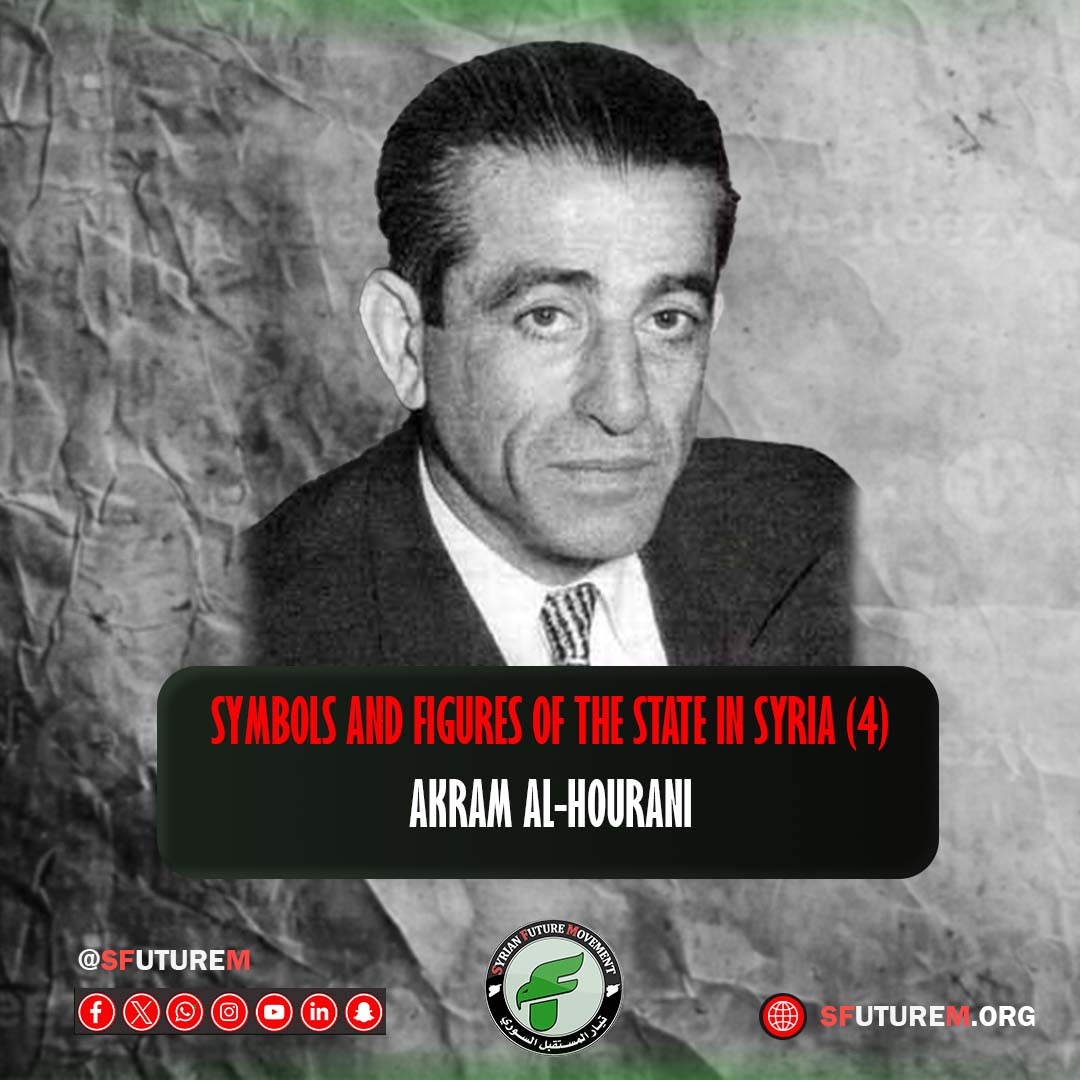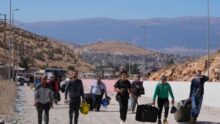Media OfficeSymbols and Figures of the State in Syria
Symbols and Figures of the State in Syria (4) Akram al-Hourani

- His full name is Akram Rashid Muhyi al-Din al-Hourani. He was born in Hama, Syria, in 1911.
- He received his primary education at the Dar al-‘Ilm wa al-Tarbiya School, a model school founded by the Syrian (and later Iraqi) King Faisal I bin al-Sharif Hussein bin Ali.
- His father, Rashid Muhyi al-Din al-Hourani, was a fabric merchant and a small landowner, as well as a devout man among the notables of Hama.
- Akram mastered Arabic and Turkish and left behind a large library containing various books on linguistics, literature, history, logic, and medicine.
- He was involved with secret societies (Al-‘Arabiyya al-Fatat) and maintained close relationships with scholars, intellectuals, and merchants.
- He was elected as a representative of the Muslims in the Hama administrative council, supporting peasants and merchants during that time against the large landowning families.
- He nominated himself for membership in the Majlis (al-Mub’uthan) representing Hama and Homs in Istanbul but was not appointed due to opposition from prominent families.
- He participated in the 1925 Revolution, where Akram al-Hourani’s political consciousness began to develop during the events of the Great Syrian Revolution (1925-1927).
- After graduating from the Institute of Science and Education in Hama, he went to Damascus and joined the elite secondary school affiliated with the state (Maktab Anbar) and graduated from there.
- He joined the Jesuit University in Beirut to study medicine.
- After a year, he returned to Damascus (1931) where he enrolled in the university to study law. His involvement in planning the assassination of deputy Subhi Barakat forced him to leave Beirut.
- After graduating from the Law College, he worked in law until he was elected as a deputy in the parliament in 1943.
- In 1936, after graduating from the Law College, he joined the Syrian Social Nationalist Party, drawn to its secular principles.
- He remained an active member until he was expelled in 1939.
- In 1941, al-Hourani and some Syrian army officers and other volunteers from the national political spectrum traveled to Baghdad to support the Rashid Ali al-Gaylani revolution against the British.
- They were detained for a period by the French Mandate government in Deir ez-Zor on the Syrian-Iraqi border upon their return.
- He led the peasant uprising in the countryside of Hama against the feudalists and was elected as a deputy for Hama in 1943, 1947, and 1949.
- He contributed to the incitement against the French presence in Hama in 1945.
- After being elected in 1943, he strengthened ties with some young officers who graduated from the Military College in Homs, such as Adnan al-Maliki and Adib Shishakli.
- He first took over the Ministry of Agriculture.
- In December 1949, he became the Minister of Defense in Khaled al-Azm’s government.
- He resigned in April, with his policy in the Ministry of Defense aimed at controlling the army and using personal relationships to advance his political project.
- He played a prominent role in building the army’s intelligence apparatus to tighten control over it.
- As Minister of Defense, he stood with the communists in the parliamentary council against alliances and against the Muslim Brotherhood in the name of secularism and liberation, accusing them of colonial servitude.
- In October 1950, Akram al-Hourani obtained a license to establish the Arab Socialist Party, making Hama its main headquarters.
- Al-Hourani organized his followers from the peasants in the Arab Socialist Party and used them against the large landowners, reaching its peak at a conference in Aleppo (September 1951) attended by thousands of peasants, the first conference of its kind (revolutionary!) in the Arab homeland.
- When Shishakli took over power, al-Hourani fled to Lebanon, where he was joined by Michel Aflaq and Salah Bitar, and in their exile in 1952, the three decided to merge the two parties (Ba’ath Arab) and (Arab Socialist) to become the Arab Socialist Ba’ath Party.
- Akram al-Hourani was named as the Vice President of the United Arab Republic “Gamal Abdel Nasser” after the unification of Egypt and Syria in 1958.
- He turned against the union and resigned from its responsibilities in 1959.
- Since then, al-Hourani fled to Lebanon, launching attack after attack against the rule of Gamal Abdel Nasser.
- After the coup on September 28, 1961, he moved to Damascus and became one of the pillars of the (Separatist Era) along with his comrades.
- After the March 8, 1963 coup (which brought the Ba’ath to power), he was stripped of his politics and civil rights, in addition to being briefly imprisoned.
- He published his memoirs in four parts, considered an important reference for a delicate phase in our Syrian history.
- He contracted cholera during World War I.
- Akram al-Hourani died in Amman in February 1996, and his funeral was attended by a few people, including some of his enemies from the Muslim Brotherhood, where he was buried.
In the Syrian Future Movement, as we recall the memory of the founding statesmen of Syria, we invoke one of the influential men of Syria, “Akram al-Hourani,” within a series we present to you, including the symbols and figures of the Syrian state, wishing to link our contemporary revolutionary present with a solid past and historical milestones, hoping to revive in our people the need to build and create exemplary statesmen, to learn from their experiences, benefit from their negatives, and build on their positives, thus preserving the nation and safeguarding its achievements, and restoring the dignity and glory of the Syrian state after years of injustice, tyranny, and corruption.






